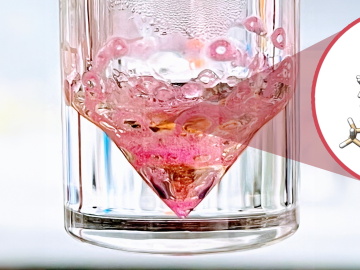
Filter News
Area of Research
News Type
News Topics
- 3-D Printing/Advanced Manufacturing (7)
- Advanced Reactors (3)
- Artificial Intelligence (15)
- Big Data (1)
- Bioenergy (7)
- Biology (9)
- Biomedical (3)
- Biotechnology (4)
- Buildings (7)
- Chemical Sciences (5)
- Clean Water (1)
- Climate Change (9)
- Composites (2)
- Computer Science (11)
- Decarbonization (12)
- Education (1)
- Emergency (1)
- Energy Storage (3)
- Environment (10)
- Exascale Computing (5)
- Fossil Energy (2)
- Frontier (6)
- Fusion (5)
- Grid (4)
- High-Performance Computing (8)
- Isotopes (8)
- Machine Learning (5)
- Materials (7)
- Materials Science (9)
- Mathematics (2)
- Microscopy (2)
- Nanotechnology (1)
- National Security (9)
- Net Zero (3)
- Neutron Science (6)
- Nuclear Energy (5)
- Partnerships (8)
- Physics (3)
- Polymers (2)
- Quantum Computing (8)
- Quantum Science (12)
- Security (2)
- Simulation (8)
- Space Exploration (3)
- Summit (4)
- Sustainable Energy (10)
- Transportation (3)
Media Contacts

When Oak Ridge National Laboratory's science mission takes staff off-campus, the lab’s safety principles follow. That’s true even in the high mountain passes of Washington and Oregon, where ORNL scientists are tracking a tree species — and where wildfires have become more frequent and widespread.

A team from ORNL successfully characterized a coordination complex of the element Promethium. The research was supported by computational simulations of the element's electronic structure run on the IBM AC922 Summit supercomputer.

ORNL researchers and communications specialists took part in the inaugural AI Expo for National Competitiveness in Washington D.C, May 7 and 8, to showcase and provide insight into how the lab is leading the way for utilizing the vast possibilities of AI.

Early career scientist Frankie White's was part of two major isotope projects at the same time he was preparing to be a father. As co-lead on a team that achieved the first synthesis and characterization of a radium compound using single crystal X-ray diffraction and part of a team that characterized the properties of promethium, White reflects on the life-changing timeline at work, and at home.

John Lagergren, a staff scientist in Oak Ridge National Laboratory’s Plant Systems Biology group, is using his expertise in applied math and machine learning to develop neural networks to quickly analyze the vast amounts of data on plant traits amassed at ORNL’s Advanced Plant Phenotyping Laboratory.

Momentum for manufacturing innovation in the United States got a boost during the inaugural MDF Innovation Days, held recently at the U.S. Department of Energy Manufacturing Demonstration Facility at Oak Ridge National Laboratory.

A group of high school graduates and community college students visited ORNL to meet staff and find out just what goes on at a DOE national laboratory. The Job Shadow Day was arranged by tnAchieves, a student support organization that works to increase higher educational opportunities for students across Tennessee through scholarships and mentorship.

Researchers set a new benchmark for future experiments making materials in space rather than for space. They discovered that many kinds of glass have similar atomic structure and arrangements and can successfully be made in space. Scientists from nine institutions in government, academia and industry participated in this 5-year study.

Students from the first class of ORNL and Pellissippi State Community College's joint Chemical Radiation Technology Pathway toured isotope facilities at ORNL.
ORNL drone and geospatial team becomes first to map the Coca River in the Amazon basin as erosion and sediment threaten Ecuador’s lands.


